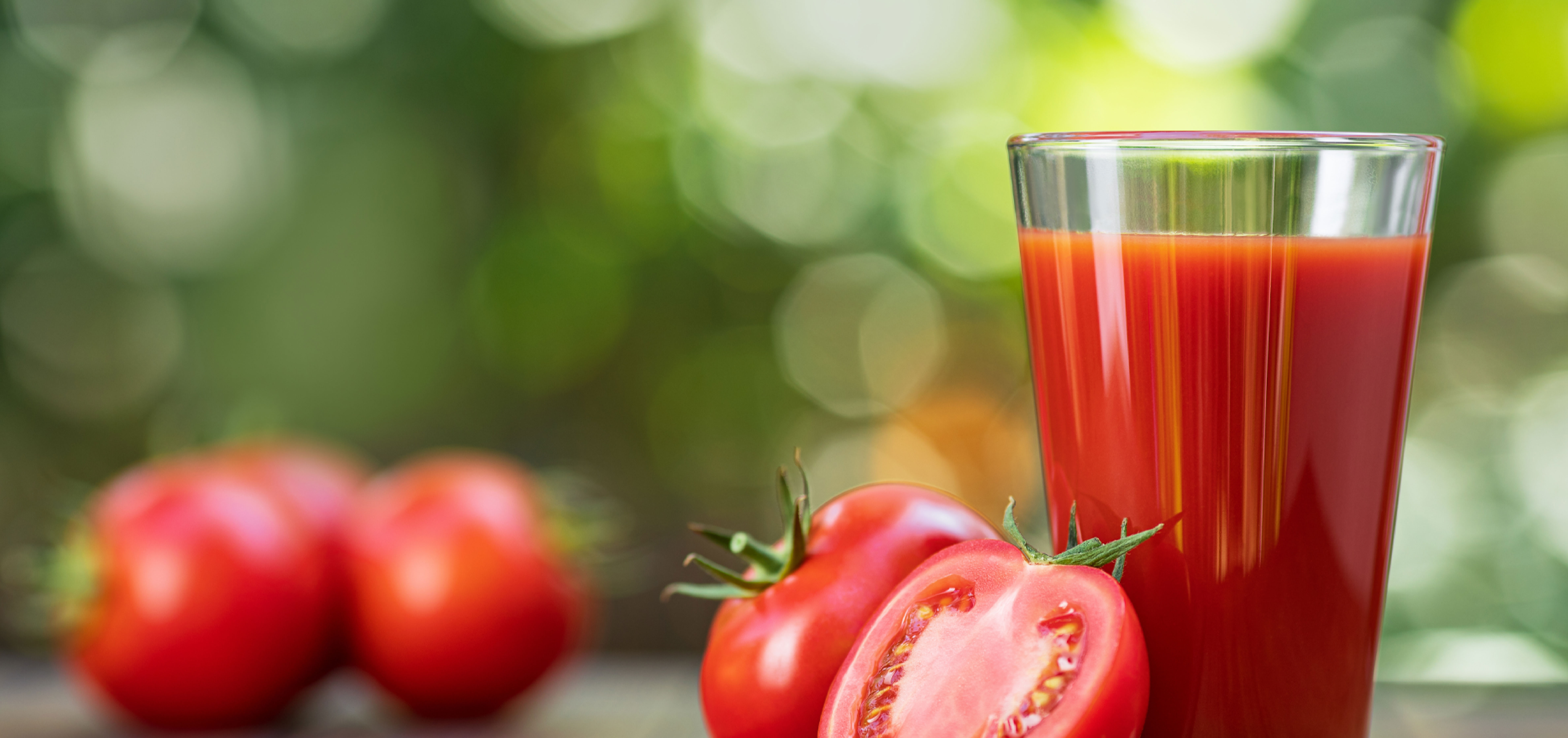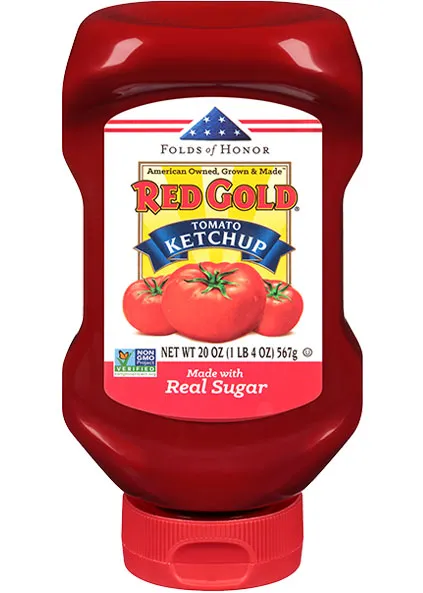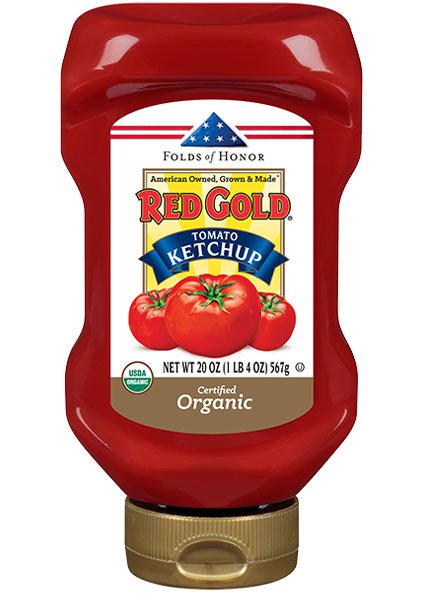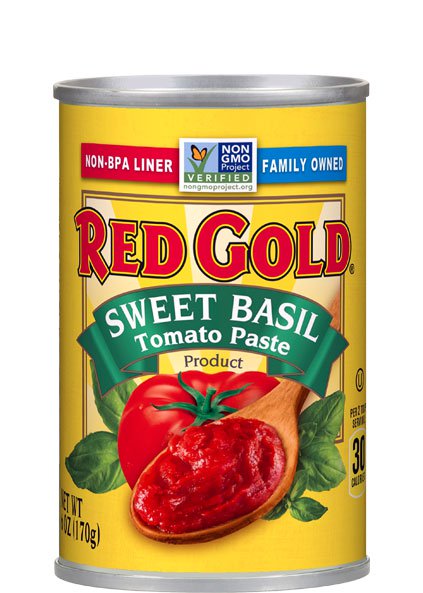

Tomato juice is often seen as a healthy choice, whether it’s served on an airplane or enjoyed as a morning beverage. But is it truly good for you? The short answer is yes. Tomato juice is packed with nutrients and offers significant health benefits, but there are a few important considerations to keep in mind.
As a family-owned company dedicated to providing the highest quality tomato products, Red Gold believes in transparency, so let’s take a factual look at what the science says about tomato juice.
Tomato Juice Nutritional Profile
A single glass of tomato juice is low in calories while delivering an impressive array of vitamins, minerals, and antioxidants. Let’s take a closer look:
- Vitamins & Minerals: Tomato juice is an excellent source of vitamin C and vitamin A (in the form of beta-carotene). It also contains significant amounts of vitamin K and various B vitamins, including folate and B6. It’s rich in essential minerals like potassium and magnesium, which are critical for heart health and muscle function.
- Antioxidants (Lycopene): The star component of tomato juice nutrition is lycopene, the powerful antioxidant that gives tomatoes their vibrant red color. Interestingly, the lycopene in processed and cooked tomato products, like canned juice, is more bioavailable. This means your body can absorb and use it more easily than the lycopene from raw tomatoes.
- Hydration & Low Calories: Made up of about 94% water, tomato juice is a fantastic hydrating beverage. An 8-ounce serving contains roughly 40 calories, making it a lean choice. Pure, 100% tomato juice contains no added sugars, setting it apart from many fruit juices that can be high in sugar.
Health Benefits of Tomato Juice
The rich nutrient content of tomato juice translates into several evidence-based health benefits that can support your overall well-being.
Heart Health and Blood Pressure
Tomato juice packs a one-two punch for cardiovascular health thanks to lycopene and potassium, two nutrients shown to support heart function and blood pressure regulation.
Lycopene, a powerful antioxidant, helps protect blood vessels and reduce the oxidation of LDL (“bad”) cholesterol—an important step in preventing plaque buildup and atherosclerosis. Meanwhile, potassium helps counteract the effects of sodium in the diet, supporting balanced blood pressure levels.
Research supports these benefits. In a year-long study of Japanese adults at risk for cardiovascular disease, participants who had free access to unsalted tomato juice experienced significant reductions in both systolic and diastolic blood pressure. The same study also found lower LDL cholesterol levels, suggesting tomato juice may offer broader cardioprotective effects when included as part of a balanced diet.
Antioxidant Power & Reduced Disease Risk
The antioxidants in tomato juice, especially lycopene, vitamin C, and beta-carotene, play a critical role in fighting inflammation and oxidative stress in the body. This protective action is linked to a lower risk of several chronic diseases.
- Cancer Risk: Numerous studies have explored the link between tomato consumption and cancer prevention. Lycopene, in particular, has been associated with a lower risk of certain cancers, most notably prostate cancer. A comprehensive review of 24 studies concluded that high consumption of tomatoes and tomato juice could lower prostate cancer risk by approximately 11%. While more human research is needed, lab and animal studies also show promising anti-cancer effects.
- Type 2 Diabetes Management: Unsweetened tomato juice has a low glycemic index, meaning it doesn’t cause a rapid spike in blood sugar. Its unique blend of nutrients may help improve insulin resistance and blood sugar control. For example, a small study demonstrated that drinking a cup of tomato juice 30 minutes before a carbohydrate-rich meal helped improve blood sugar levels after the meal.
Additional Benefits
The health benefits of tomato juice extend beyond heart health and disease prevention.
- Vision and Skin Health: The vitamin A and beta-carotene in tomato juice are essential for maintaining healthy vision. Meanwhile, its high vitamin C content supports collagen production, which is key for skin elasticity and wound healing. Lycopene may also offer some protection against skin damage from UV rays.
- Digestive Health: While it doesn’t contain as much fiber as whole tomatoes, tomato juice still provides some fiber along with ample fluid. This combination aids hydration and can act as a mild laxative for some, helping to promote regular digestion.
- Weight Management: Tomato juice can be a smart addition to a weight-conscious diet. It is low in calories but can be surprisingly filling. Research has linked daily tomato juice consumption to reductions in body weight and waist circumference in overweight women. Replacing sugary, high-calorie drinks with tomato juice can be an effective strategy for weight control.
- Immune Support: With its high concentration of vitamin C and other antioxidants, tomato juice helps support a healthy immune system by protecting the body from oxidative stress.
Potential Downsides of Drinking Tomato Juice
To make an informed choice, it’s also important to be aware of the potential downsides of tomato juice.
- High in Sodium: The biggest concern with many commercial tomato juices is the sodium content. Some popular brands contain 600–800 mg of sodium per cup, which is about 25–35% of the recommended daily limit. A high-sodium diet can contribute to high blood pressure, increasing the risk of heart disease and stroke. It’s important to look for “low-sodium” or “no-salt-added” versions. For example, unsalted tomato juice typically contains only about 25 mg of naturally occurring sodium per serving, compared to over 630 mg in its salted counterpart.
- Acidic Nature: Tomatoes are naturally acidic. For individuals with gastroesophageal reflux disease (GERD) or a sensitive stomach, drinking tomato juice, especially on an empty stomach, may trigger heartburn or other uncomfortable symptoms.
- Potassium Considerations: While most people benefit from potassium, tomato juice is high in it, with about 430 mg per 8-ounce serving. Individuals with kidney disease or those taking certain medications (like ACE inhibitors or potassium-sparing diuretics) may need to limit their potassium intake. If you have a condition that requires potassium monitoring, it’s best to consult your doctor.
- Lower Fiber Than Whole Tomatoes: If high fiber is a priority in your diet, be aware that juicing removes a significant portion of the fiber found in whole tomatoes. A cup of tomato juice has only 1–2 grams of fiber, so it doesn’t offer the same digestive and blood sugar-stabilizing benefits as eating a whole tomato. However, it still contains more fiber than many other common juices, like apple or orange juice.
Tips for Choosing the Healthiest Tomato Juice
- Read the Label: Opt for products labeled “100% tomato juice” to avoid added sugars, high-fructose corn syrup, or other unwanted additives.
- Check the Sodium: Always look at the nutrition facts. Choose “No Salt Added” (around 25 mg of sodium) or “Low Sodium” (less than 140 mg) varieties to control your intake.
- Consider the Processing: Canned tomato juice is typically heat-processed. This method actually helps increase the bioavailability of lycopene, making it a great nutritional choice.
- Try Making It Homemade: For ultimate control over ingredients, blend ripe tomatoes in a blender, strain if desired, and season lightly. Adding a small amount of a healthy fat, like olive oil, can help your body absorb even more lycopene.
- How to Enjoy It: A half-cup to a full cup per day is a great target to reap the benefits. It works well in the morning or as a post-workout drink to replenish electrolytes like sodium and potassium.
Other Uses for Tomato Juice
Tomato juice can be used for other purposes as well!
Cooking with Tomato Juice

Red Gold’s Fresh Squeezed Tomato Juice provides a bright, savory base that adds depth and body to a wide range of dishes. From hearty soups and stews to tangy braises, marinades, and even savory baked goods, it’s the secret to creating dishes that are both deeply flavorful and satisfyingly wholesome.
Here are some examples of tomato juice as a versatile kitchen ingredient:
- Soups and Stews: Use it as a nutrient-rich base for chili, minestrone, or vegetable soup. See our recipe library of chili, soups, & stews!
- Marinades and Sauces: Its acidity helps tenderize meat, making it a terrific addition to marinades. It can also enrich pasta sauces. See our recipe library of rich sauces!
- Grain Dishes: Replace some of the water with tomato juice when cooking rice or quinoa to add flavor, color, and nutrients. See our recipe library of pasta & rice dishes!
- Smoothies and Mocktails: Blend it with celery, cucumber, and a squeeze of lemon for a savory and refreshing drink.
For more inspiration, explore the Red Gold recipe library, where you’ll find exciting new ways to cook with this pantry staple.
Consider Packaging and Storage for Freshness & Safety
How your tomato juice is packaged matters for freshness, safety, and convenience.
Canned Tomato Juice
Offer a long shelf life and protect nutrients from light and air. Many modern brands, including Red Gold, use BPA-free can linings. Once opened, transfer unused juice to a different container for storage.
Plastic Bottles
These are lightweight, shatter-resistant, and resealable. However, they are less effective at blocking oxygen and light, and it’s best to avoid storing them near heat.
Glass Bottles
Glass is an inert material that doesn’t react with the juice, preserving its flavor. While heavier and more fragile, a glass bottle is a great option for quality.
Cartons (Tetra Pak-style)
Lightweight and often shelf-stable, cartons are easy to pour from. However, their recyclability can vary depending on local facilities.
The Bottom Line: Should You Be Drinking Tomato Juice?

Yes, tomato juice can be a very healthy addition to a balanced diet. It’s a low-calorie beverage loaded with vitamins, minerals, and powerful antioxidants like lycopene that support everything from heart health to immune function.
The key is to drink it in moderation and make smart choices. Always opt for a 100% juice, no-salt-added tomato juice to avoid excess sodium. If you have GERD or specific potassium restrictions, you may need to limit your intake.
At Red Gold, our commitment to quality ensures our fresh squeezed tomato juice delivers the wholesome goodness of tomatoes in every sip, with options like no-salt-added to fit your health goals. This dedication to excellence has earned our tomato juice the ChefsBest Excellence Award. To learn more about our quality standards, visit our Red Gold quality page.
Disclaimer:
The information provided in this article is for educational and informational purposes only and is not intended as a substitute for professional medical advice, diagnosis, or treatment. If you have questions about adding tomato juice to your diet or any other health-related matters, please consult your family physician or a registered dietitian. Always seek the advice of your healthcare provider with any questions you may have regarding a medical condition or dietary changes.





